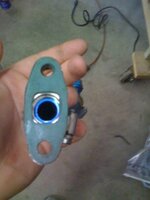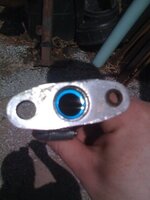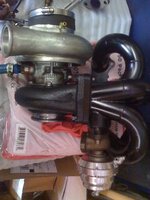1SloColt
15+ Year Contributor
- 280
- 6
- Sep 24, 2004
-
port royal,
Virginia
This is the problem. A small oil drain obviously will not make this matter better. Its the high volume that kills turbos, and you obviously need a drain tube ID that corresponds to the amount of oil being sent at such a high volume/pressure. An .080" restrictor in a -4an feed line is necessary off the oil filter housing, although I have seen standard bearing turbos successfully run a straight -4an feed line for a sustained period of time without issues. I would even try down to a .060" restrictor just to keep volume down. A 1/2" ID drain for a .060" restrictor in a -4an feed line should work just fine. -3an wouldn't be a bad route either. In any of these cases I would advocate a minimum 1/2" ID drain line be utilized. I have been running a precision SCM cartridge turbo for 3 years with a .076" restrictor in a -4an feed off the filter housing on a -10an return line. These cartridges are known for taking a dump due to too much oil pressure/volume. I've yet to see that problem with my oil feed/drain setup.The truth is if you're firing 80psi of high-volume oil pressure into one of these turbos






 especially ### i am gonna need a longer one anyways. just hope that one of the vendors will be able to help out and maybe get something rolling on some giant AN fittings and lines.
especially ### i am gonna need a longer one anyways. just hope that one of the vendors will be able to help out and maybe get something rolling on some giant AN fittings and lines. I had a kink in my return line and had around 80 PSI at 3000 RPM cruise and WELL over 100 PSI at WOT.
I had a kink in my return line and had around 80 PSI at 3000 RPM cruise and WELL over 100 PSI at WOT.












